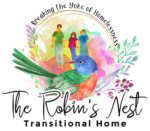Welcome To
The Robin's Nest Transitional Home
The Robin’s Nest provides transitional housing for homeless men, women, and their dependent children. It also offers shared living in a home environment, family counseling, financial literacy, love, and support.
Shelter & Transitional Housing
Our 5 Guiding Principles
- We work to empower individuals.
- We provide research-based best practice case management in our homes.
- We make the most of available resources through careful stewardship of gifts, grants, and through collaboration and partnerships with other organizations.
- We work to provide a stable environment that produces thriving children.
- We are an example of excellence for other transitional housing programs.
Secure Christ inspired atmosphere
Our secure Christ inspired atmosphere is a place where families are nurtured, spiritually fed, and embraced with love and compassion. Within our transforming environment, a parent can focus on budgeting, life skills, continued education, employment, parenting, overcoming the circumstances that led to homelessness, and rest. Children are empowered with love and a focus on school and their personal development. The program provide intensive case management, life skills and child development services. Preparation for self-sufficiency through employment and the ability to sustain independent permanent housing are outcome measures for this program.
Our Story
It was a bright sunny day and my turn to pick up our daughter from school. I noticed that she was not waiting alone as I arrived to pick her up. As she entered the car, she asked if I could give a young man a ride home. I agreed and began driving in the direction that I thought he might live. As I entered the subdivision, I asked in which house he lived. He responded, “neither,” and indicated that I passed the place where he lived. I began to ponder as I proceeded to turn around and thought to myself, I don’t recall passing an apartment building or subdivision before arriving at the location I had chosen. This time, I drove slowly to ensure that I would not miss it again. However, as we proceeded to a stop sign on the street, the young man instructed me to “turn here”. I began to turn into a large hotel where I was to drop him off when I noticed a school bus entering the same parking lot to unload at least 10 more children.
I never thought much of the occasion past the moment of dropping him off until years later. I was reminded of that very day and how smart the young man must have been, how well he dressed, how respectful and clean he appeared. He did not look like his homelife experiences or the conditions in which he was living. He did not physically appear to be homeless, so I did not think he was homeless. As the days grew into weeks and months, the desire to look closer at the circumstances I had witnessed dominated my thoughts. I later learned that homelessness did not look the same for every family.
I also learned that a person could have a job and go to work each day or to school with clean clothes and still be defined as homeless. Physical appearances can often camouflage living conditions. To ensure that our children have different experiences, we must expose them to better environments and opportunities, including their conditions at home. We must help those families who are employed, yet for many reasons, find themselves on the couches of friends and families, in shelters, hotels, and even sleeping in their vehicles. Since the pandemic, more families are finding it difficult to stay afloat and more difficult to recover from the snowball effort of insufficiencies. The Robin’s Nest Transitional Home was birthed to provide those families with the tools needed to take flight from inadequate living conditions to a place of hope, independence, and stability.
